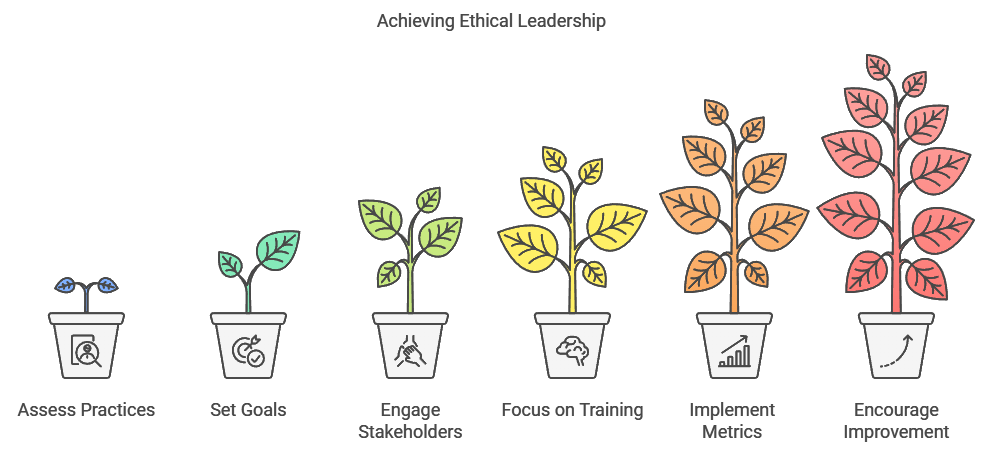Introduction
In the modern business landscape, organizations are increasingly expected to look beyond mere financial success and towards broader objectives that encompass ethical practices and sustainability. This calls for leaders who can blend traditional leadership with a purpose-driven approach that benefits not only the business but also society and the environment. This guide will outline essential strategies and steps for adopting a leadership style that is purpose-driven, ethical, and aligned with sustainable practices.
Understanding Purpose-Driven Leadership
What is Purpose-Driven Leadership?
Purpose-driven leadership involves guiding an organization with a mission that serves the greater good, beyond revenue and profit margins. This leadership style is built on principles like:
- Authenticity: Staying true to personal and organizational values.
- Compassion: Prioritizing empathy and concern for others.
- Sustainability: Focusing on long-term resource use and environmental impact.
- Ethical Integrity: Following moral principles in decision-making.
- Long-term Thinking: Prioritizing future benefits over short-term gains.
Why It Matters
Purpose-driven leadership is crucial for building resilient organizations that thrive amid challenges such as climate change and social inequality. It enhances company reputation, fosters innovation, and aligns business goals with societal needs, which are critical for long-term success.
Aligning Leadership with Ethical Practices
Building a Code of Ethics
A code of ethics is essential for embedding ethical behaviors within an organization. It should clearly outline expected actions and decision-making processes that align with both company values and wider societal expectations.
Ensuring Transparency
Transparency is a cornerstone of trust and accountability. Leaders must ensure open communication about company decisions, practices, and impacts, giving stakeholders a clear view of the organization’s conduct and intentions.
Promoting Human and Ecological Well-Being
Recognizing Interconnections
Leaders need to understand how their operations impact broader social and environmental systems. This includes examining supply chains, resource usage, and employment practices to identify areas where they can make a positive difference.
Aligning with Sustainable Development Goals (SDGs)
The SDGs provide a global framework for aligning business strategies with societal and environmental priorities. By incorporating these goals, organizations can structure their strategies to address issues like poverty, environmental degradation, and social injustice effectively.
Steps for Implementation

Assessing Current Practices
Start by evaluating existing leadership practices to identify alignment with ethical and sustainable principles. Look for discrepancies and pinpoint areas for improvement.
Setting Clear Goals
Define what ethical and sustainable leadership means for your organization. Create specific, measurable goals that integrate with your business objectives and reflect the broader societal mission.
Engaging Stakeholders
Including a variety of stakeholders such as employees, customers, and community members is critical to gaining insights and establishing expectations. Their feedback can inform leadership strategies and decisions.
Focusing on Training
Develop comprehensive training programs that expand leaders’ understanding of ethical practices, sustainability, and crisis management. Emphasize the importance of having a purpose that extends beyond profits.
Implementing Metrics and Evaluations
Use specific metrics and Key Performance Indicators (KPIs) to monitor leadership effectiveness in upholding ethical and sustainable standards. Regular evaluations and audits can help in assessing progress and driving continuous improvement.
Encouraging Continuous Improvement
Foster a culture of ongoing learning and adaptation. By encouraging feedback and innovative thinking, leaders can continuously evolve their strategies to meet emerging challenges and opportunities.
Learning from Successful Examples
Patagonia
Patagonia stands as a model for integrating environmental concerns and ethical labor practices throughout their leadership and business operations, demonstrating how purpose-driven goals create long-term value.
Unilever
Unilever’s Sustainable Living Plan emphasizes long-term stakeholder value and reshapes corporate strategy by incorporating sustainability into the core of their leadership approach.
Addressing Challenges
Overcoming Resistance to Change
Organizational change may face resistance. Strategies to tackle this include promoting inclusive decision-making and maintaining transparency to create buy-in from all levels of the organization.
Balancing Profit with Purpose
Finding the right balance between achieving short-term financial goals and upholding long-term ethical and sustainability objectives can be challenging. Leaders need to integrate financial performance with a broader purpose, ensuring they fulfill both economic and societal responsibilities without compromise.
Conclusion
Adopting a purpose-driven leadership style is not just about keeping up with trends but is instead a necessary shift towards sustainable and ethical business practices. By focusing on broader goals that encompass human and ecological well-being, leaders can ensure they build resilient, innovative organizations that resonate with today’s global challenges and stakeholder expectations. This guide provides a roadmap for leaders seeking to innovate their approach, ensuring they remain competitive and aligned with the pressing needs of the world we live in.
Leave a Reply